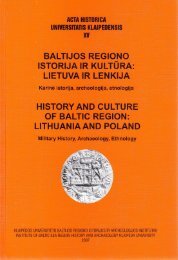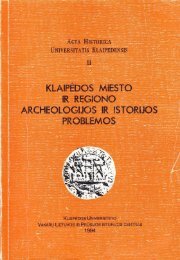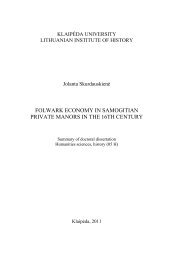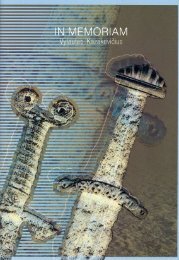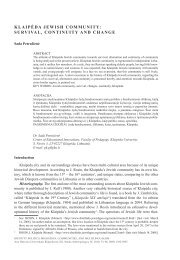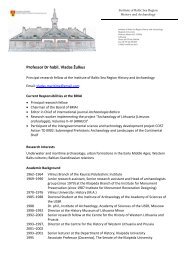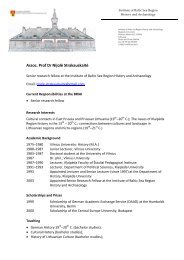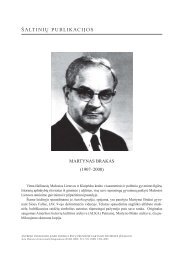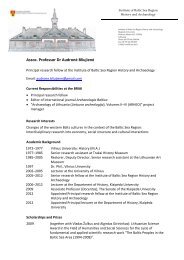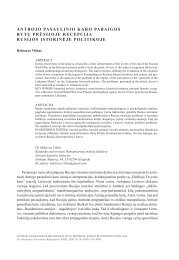university of klaipėda lithuanian institute of history roman širouchov ...
university of klaipėda lithuanian institute of history roman širouchov ...
university of klaipėda lithuanian institute of history roman širouchov ...
You also want an ePaper? Increase the reach of your titles
YUMPU automatically turns print PDFs into web optimized ePapers that Google loves.
Ekritten or Nr. 17 <strong>of</strong> Povarovka, appear within the boarder <strong>of</strong> old Prus-<br />
sian cremation cemeteries under the strong influence <strong>of</strong> foreign burial<br />
traditions. Already Christian inhumations and so named “chamber<br />
graves” <strong>of</strong> the 11 th -13 th centuries were known on Poland’s territory.<br />
Although inhumation graves hade become the main form <strong>of</strong> burial rite<br />
in Prussia only by the end <strong>of</strong> the 13 th century. This passage is very im-<br />
portant to show the difference between Prussian and Curonian cultural<br />
realities on the boarder <strong>of</strong> the 12 th -13 th centuries.<br />
III. Trading centers and routes in the territory <strong>of</strong> Prussians and<br />
Curonians in the 11 th –13 th centuries<br />
III.1. Curonian Spit, as possible area for direct cultural transaction<br />
<strong>of</strong> Prussian and Curonian cultures<br />
28<br />
All investigated archaeological monuments are located in the<br />
Southern part <strong>of</strong> Curonian Spit and dated by the 13 th -15 th centuries in<br />
case <strong>of</strong> Stangenwalde cemetery and by the 12/13 th -14 th centuries for<br />
Korallen-Berg settlement. Materials <strong>of</strong> Stangenwalde inhumation<br />
graves have a wide range <strong>of</strong> parallels and analogies with Prussian<br />
cemeteries <strong>of</strong> the Teutonic Order period as Alt-Wehlau, Gerdauen-<br />
Kinderh<strong>of</strong>, Mitino, Równina Dolna etc. Some archaic artefacts as<br />
penannular brooch with connected star-shaped terminals and also spiral<br />
bracelet and drinking horn mount <strong>of</strong> Curonian types could appear here<br />
far behind the date <strong>of</strong> their production, from areas <strong>of</strong> Sambia and to-<br />
day’s Klaipeda district respectively. Perhaps, it is the same case for



